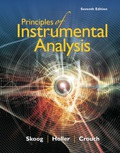
Principles of Instrumental Analysis
7th Edition
ISBN: 9781337468039
Author: Skoog
Publisher: Cengage
expand_more
expand_more
format_list_bulleted
Concept explainers
Question
Chapter 7, Problem 7.13QAP
Interpretation Introduction
Interpretation:
Number of lines of IR grating is 90 lines per millimeter and the illumination of this grating occurs at 15.0 mm. First order resolution of this IR grating needs to be calculated and the distance between the two resolved lines is to be determined when they are centered at 1200 cm-1.
Concept introduction:
Formula for the resolving power of grating is as follows:
Calculation of distance between two resolved lines can be done using the following formula:
Expert Solution & Answer
Trending nowThis is a popular solution!

Students have asked these similar questions
when performing the reaction that involves 2 equivalents of 3-(diethylamino)-phenol and Phthalic anhydride with sulfuric acid and water react to form rhodamine b where the Phthalic anhydride cleaves in acid and how does Excessive Washing (w/ Base) & Subsequent Resonance Structure get affected
Part C
A solution that is 0.040 M in HCIO4 and 0.046 M in HCI
Express your answer numerically to two decimal places.
ΜΕ ΑΣΦ
?
pH =
Submit
Request Answer
Part D
A solution that is 1.08% HCl by mass (with a density of 1.01 g/mL)
Express your answer numerically to three decimal places.
ΜΕ ΑΣΦ
->
0
?
pH =
Predict the equilibrium arrows for the following reaction:*see image
Chapter 7 Solutions
Principles of Instrumental Analysis
Ch. 7 - Prob. 7.1QAPCh. 7 - Prob. 7.2QAPCh. 7 - The Wien displacement law states that the...Ch. 7 - Prob. 7.4QAPCh. 7 - Prob. 7.5QAPCh. 7 - Describe the differences and similarities between...Ch. 7 - Prob. 7.7QAPCh. 7 - Prob. 7.8QAPCh. 7 - Prob. 7.9QAPCh. 7 - Prob. 7.10QAP
Ch. 7 - Why is glass better than fused silica as a prism...Ch. 7 - Prob. 7.12QAPCh. 7 - Prob. 7.13QAPCh. 7 - Prob. 7.14QAPCh. 7 - Prob. 7.15QAPCh. 7 - Prob. 7.16QAPCh. 7 - Prob. 7.17QAPCh. 7 - Prob. 7.18QAPCh. 7 - Prob. 7.19QAPCh. 7 - Prob. 7.20QAPCh. 7 - Prob. 7.21QAPCh. 7 - Prob. 7.22QAPCh. 7 - Prob. 7.23QAPCh. 7 - Prob. 7.24QAP
Knowledge Booster
Learn more about
Need a deep-dive on the concept behind this application? Look no further. Learn more about this topic, chemistry and related others by exploring similar questions and additional content below.Similar questions
- Provide the missing information for each of the two following reacitons: *see imagearrow_forwardDraw an example of the following functional groups: *see imagearrow_forwardAldehydes and Ketones: Show the reaction conditions, and molecules, that connect the reactant to the product. A protecting group will be needed. *see imagearrow_forward
- Aldehydes and Ketones: Show the reaction conditions, and molecules, that connect the reactant to the product. *see imagearrow_forwardProvide the missing information for each of the four reactions: *see imagearrow_forward6. Chlorine dioxide (CIO) is used as a disinfectant in municipal water-treatment plants. It decomposes in a first-order reaction with a rate constant of 14 s. How long would it take for an initial concentration of 0.06 M to decrease to 0.02 M? [6 pts]arrow_forward
- If possible, replace an H atom on the a carbon of the molecule in the drawing area with a methyl group substituent, and replace an H atom on the ẞ carbon with a hydroxyl group substituent. If one of the substituents can't be added for any reason, just don't add it. If neither substituent can be added, check the box under the drawing area. en HO OHarrow_forwardCurved arrows are used to illustrate the flow of electrons. Use the reaction conditions provided and follow the curved arrows to draw the intermediate and product of this hydrohalogenation reaction. Include all lone pairs and charges as appropriate. Br Select to Draw 51°F Sunny esc F1 HBr Select to Draw 1,2-hydride shift Br Select to Draw Q Search F2 F3 F4 1 2 # # 3 DII L F5 F6 F tA $ % Λarrow_forwardplease help i cant find the article to even startarrow_forward
- What are the missing reagents for the spots labeled 1 and 3? Please give a detailed explanation and include the drawings and show how the synthesis proceeds with the reagents.arrow_forwardhelp with the rf values i am so confusedarrow_forwardPredict the organic reactant of X and Y that are involved in the reaction below, and draw the skeletal ("line") structures of the missing organic reactant. Please include all steps & drawings & explanations.arrow_forward
arrow_back_ios
SEE MORE QUESTIONS
arrow_forward_ios
Recommended textbooks for you
 Principles of Modern ChemistryChemistryISBN:9781305079113Author:David W. Oxtoby, H. Pat Gillis, Laurie J. ButlerPublisher:Cengage Learning
Principles of Modern ChemistryChemistryISBN:9781305079113Author:David W. Oxtoby, H. Pat Gillis, Laurie J. ButlerPublisher:Cengage Learning Principles of Instrumental AnalysisChemistryISBN:9781305577213Author:Douglas A. Skoog, F. James Holler, Stanley R. CrouchPublisher:Cengage Learning
Principles of Instrumental AnalysisChemistryISBN:9781305577213Author:Douglas A. Skoog, F. James Holler, Stanley R. CrouchPublisher:Cengage Learning

Principles of Modern Chemistry
Chemistry
ISBN:9781305079113
Author:David W. Oxtoby, H. Pat Gillis, Laurie J. Butler
Publisher:Cengage Learning

Principles of Instrumental Analysis
Chemistry
ISBN:9781305577213
Author:Douglas A. Skoog, F. James Holler, Stanley R. Crouch
Publisher:Cengage Learning
